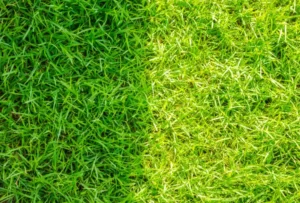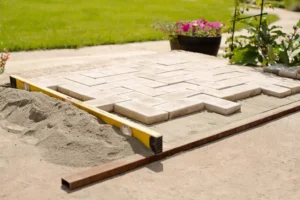The choice between artificial turf and natural grass is one such dilemma that homeowners are being faced with more and more these days. This dilemma is being created due to issues such as climate change and the resulting desire to have a well-maintained backyard, making one wonder whether it is more rational to choose to have a backyard full of natural grass or artificial turf. This article will present a comprehensive comparison between artificial grass vs natural grass on factors such as aesthetic appeal, price, upkeep, eco-friendliness, safety, and functionality.
Appearance | Natural Beauty vs Consistent Perfection
Typically, one factor that is almost immediately assessed within artificial grass vs natural grass comparisons is appearance.
Real Grass
The advantage of grass is that it provides a natural look that develops seasonally. Grass is attractive because of its feel, minor flaws, smell, and movement when blown by air. A natural grass is cooling to touch and is very refreshing to have around.
However, natural grass requires care concerning weather factors.If natural grass is exposed to a considerable amount of sunlight, it will turn brown, while if exposed to heavy rainfall, it will result in muddy grass.Shade can result in patchy grass. It is no easy task to keep grass looking like that perennial shade of green.
Artificial Turf
The newer artificial turf looks very natural because of two-toned fibers, textures, and improved manufacturing technology. This type of turf will continue to look greener regardless of the seasons without any attention regarding weather, bugs, and soil.
Artificial turf is ideal if you desire a grassed area that has exactly the same look each and every day.
Maintenance: Time, Effort, and Cost
Amongst the deciding factors concerning artificial turf versus grass is the issue of maintenance.
Maintenance for Natural Grass
The upkeep of natural grass entails:
- Watering regularly
- Weekly mowing
- Fertilizers & Nutrient Management
- Weeds and pest control
- Seasonal aeration
Seeding to repair dead spots The level of care required entails time and resources. Even if you hire a gardener to take care of your plants, you will continue to pay on a monthly basis. This can actually amount to much more money by the end of a whole year.
Maintenance for Artificial Turf
Artificial grass requires very little maintenance because:
- Occasional rinsing to remove dust
- Light brushing to raise fibers
- Removing Leaves Or Debris
- Sanitizing pet zones if required
There are no cutting, watering, or fertilization required. Synthetic grass seems the more convenient option for the frequently employed individual who enjoys low-maintenance landscaping choices.
Cost | Upfront vs Long-Term Investment
Initial Installation
- Real Grass: This form of lawn requires very low investment. As the grass seeds grow, the lawn requires very low maintenance costs.
- Artificial Turf: A higher setup price due to excavation costs as well as grass laying.
Long-Term Costs
This is where artificial turf can make economic sense. Natural grass entails ongoing outlays:
- Water
- Fertil
- Pestic
- Tools and equipment
- Gardener fees
Patching up Within a short period, such expenses can surpass the initial amount one needs to pay to install artificial grass. Though synthetic grass comes with a higher initial cost, it helps many homeowners cut expenses.
You may read Is Artificial Turf Good for Dogs?
Environmental Impact: Which Is More Eco-Friendly?
But the environmental debate regarding natural grass versus synthetic grass grass is quite complex. Both have their pros and cons.
Environmental Pros of Real Grass
- Liberates oxygen and absorbs oxygen dioxide
- Maintains low temperature.
- Supports the growth of soil organisms and insects
- Assists the absorption of rainfall into nature
- Environmental Disadvantages of Real Grass
Environmental Cons of Real Grass
- Contributes greatly to water consumption, particularly during hot seasons.
- Fertilisers and pesticides could affect the environment.
- Gas-powered lawn mowers emit air pollution.
- Watering that results in water being wasted could negatively
Environmental Pros of Artificial Turf
- Saves thousands of gallons of water every year
- No fertilizer or pesticide required
- No mowing require.
- A long lifespan generates low waste.
Environmental Cons of Artificial Turf
- These products are made of plastic materials that consume a lot of power during their production
- Can get hot under direct sunlight
- Disposal after 15-20 years must be managed carefully.
IArtificial grass may well prove more environmentally-friendly when water availability is low because it avoids water waste altogether. On the other hand, in areas with lots of rainfall, natural grass may prove more environmentally-friendly because it recycles rainfall.
Durability and Lifespan
Real Grass
Natural grass deteriorates due to overuse. Heavy-usage zones may result in uneven patches or muddy conditions. Grass height can further affect this issue.
Artificial Turf
Artifical grasses are meant to withstand daily usage. Also, they never get muddy and uneven, with the better varieties lasting up to 15-20 years. This makes them suitable for the following purposes:
- Playgrounds
- Pet areas
- Sporting Grounds
High-traffic back Natural grass cannot compare to artificial grass regarding durability.
Comfort and Safety Factors
Comfort of Natural Grass
Actual grass will remain cool and soft under the feet. Additionally, natural grass will offer natural cushioning. On the other hand, real grass could hold insects and allergens that could result in slips or irritation.
Comfort of Artificial Turf
Artifical grass feels soft and smooth; but:
- It can heat up on hot days
- Some forms of infill could feel stiffer.
- Outdoor play with bare feet may well feel unpleasant if the weather outside is too hot
Selecting cooling materials and shaded areas assists in cooling the grass pitch.
Pets and Kids: Which Is Better?
Natural Grass for Pets and Children
Pets prefer the natural grass that their owners possess, although natural grass faces the following disadvantages with respect to
- Muddy paws
- Digging
- Yellow urine spots
- Allerg
- Insects
Children like natural grass too; however, their presence may introduce dirt into the house.
Artificial Turf for Pets and Kids
Synthetic grass provides:
- No mud
- Fast Drainage
- Cleaner play areas
- No pesticides
No Digging Cleaning of waste with ease Pet-friendly grass types include odor-reducing layers and antibacterial material. This makes them suited for families with pets.
Weather Performance
Real Grass
Natural grass responds the most effectively to the weather conditions. This is due to the fact that the elements affect the grass directly. Heat burns the grass. Grass normally requires sunlight so that it may grow well.
Artificial Turf
Effects of the weather on the synthetic grass are minimal. The grass looks green at all seasons and under various conditions of shade and direct sunlight.
Installation and Convenience
Real Grass Installation
Installing real grass is easy and affordable. All that’s required is that you prepare the area of land and water it regularly. But establishment may take weeks or even months.
Artificial Turf Installation
Turfing requires more expertise than the other operations; this activity involves the removal of the natural soil layer on the surface of the land, addition of a base layer, leveling of the surface, draining of the area, and final fixation of the grass layer.
Making the Right Choice
Choosing between fake grass vs real grass depends on your lifestyle, climate, budget, and personal preference.
Choose Artificial Turf If You Want:
- Low-maintenance requirement.
- No watering
- Perfect beauty throughout the year
- Clean playing areas
- Pet-friendly surfaces
- Long-term durability
Choose Real Grass If You Want:
- Natural beauty.
- Cooler surface temperature
- A natural lawn that supports the environment.
- The typical scent and texture of natural grass
Conclusion | Artificial Turf vs Real Grass
Synthetic grass vs natural grass doesn’t have a clear winner—efficiency meets beauty in this ongoing debate.
While synthetic turf offers low maintenance and long-term durability, natural grass provides that classic, organic appeal.
Your final choice comes down to which factor matters most to you. For expert artificial grass installation San Jose, trust Lakota Design Group. Transform your outdoor space with professional quality and style. Contact Lakota Design Group today to get started!
FAQs
1. Is artificial turf easier to maintain than real grass?
Absolutely. Artificial turf requires no mowing, watering, or fertilizing, making it a low-maintenance choice compared to the ongoing care real grass needs.
2. Does artificial turf stay green all year round?
Yes. One of the biggest advantages of artificial turf is its year-round fresh, green appearance, regardless of weather or season—something real grass can’t always deliver.
3. Is artificial turf durable for kids and pets?
High-quality turf is designed to withstand heavy use, making it ideal for families with kids and pets who want a lawn that looks great without patchy or muddy spots.
4. How long does artificial turf last compared to real grass?
Artificial turf typically lasts 10–20 years with minimal upkeep, while real grass may require frequent repairs, reseeding, or replacement depending on foot traffic and climate.
5. Is artificial turf more cost-effective in the long run?
Although the initial installation cost is higher, artificial turf often saves money over time due to reduced water usage and almost no maintenance costs.





